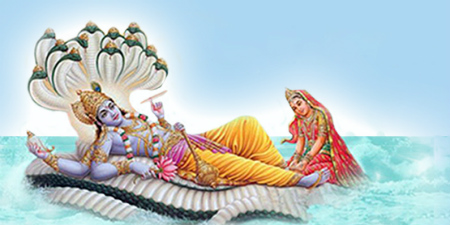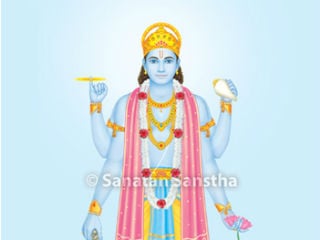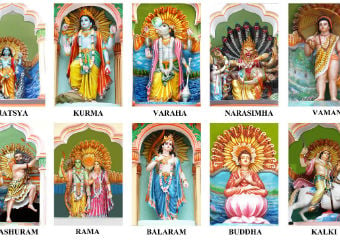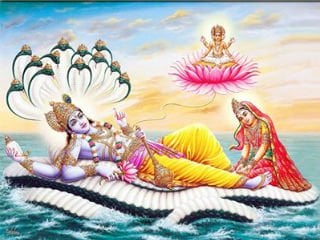Contents
We find Idols of Shri Vishnu as ancient as the 2nd Century to 8th Century. Shri Vishnu is described as ‘चतुर्णांपुरुषार्थानांदाता’ -One who imparts all the four Purusharthas;hence, He has four hands.

1. Weapons, ornaments, family and the underlying meaning
| Organ / Family | Weapon /Ornament | Name | Colour | Mission / Underlying meaning |
|---|---|---|---|---|
| 1. Head | Crown | Kutastha | – | Sattva |
| 2. Ears | Kundal | – | – | Perishable and nonperishable principles |
| 3. Neck | Garland of flowers | Vaijayanti | Panchavarna | Adya and Ajaya Shakti (Divine Energy) |
| 4. Chest | Precious stone | Kausthubha | Red | Tej (Absolute Fire Principle) |
| 5. Hands | ||||
| A. | Conch | Panchajanya | Purnachandra | Panchamahabhuta-oriented Shabdabrahman (Divinity in words) or blessings at the time of commencement of war |
| B. | Chakra | Sudarshanchakra | Sahastrasurya | Weapon that has to be hurled, used for fighting from a distance |
| C. | Gada (Mace) [One that is touching the ground near the right foot] | Kaumodaki | Krushna (Black) | Weapon used for close fights, Adividya (Primitive Knowledge), form of mahat (Great), Shakti that demolishes the ego |
| D. | Padma (Lotus) | – | – | Creation, environment, Shanti (Peace) |
| E. | Bow | Shangarga | – | Adimaya (Primal energy) |
| 6. Family | ||||
| A. Wife | – | Shri Lakshmi | Gold | Shakti |
| Wife | – | Pushti | Shirishapushpa | Shakti |
| B. Nag (Serpent) | – | Ananta | Cloud | Pavitrak |
| C. Vehicle | – | Eagle | Lotus | Vehicle |
- Vaijayanti = ‘Vai’ + ‘jayanti’. In Sanskrut ‘Vai’ means many eras and ‘jayanti’ means chains. One who wears the chain of Vaijayanti around the neck, meaning, One who wears many eras around His neck like chains, who transcends time is Shri Vishnu.
- The rotating chakra means Maya (The Great Illusion), and the finger that is steady around which it rotates is Brahman.
- Shri Lakshmi:Shakti that is constantly in motion and destroys the mind (desires) and bad aspects. Shri Lakshmi is seated near the feet of Shri Vishnu. (Parvati is seated on Shiva’s lap. This togetherness of Shiva-Parvati is dissolution of duality between them, meaning, existence of non-duality.)
A. Implied meanings of weapons
| Weapon | Implied meaning | Nad (Sound) |
|---|---|---|
| 1. Shankha(Conch) | Doubt | Sound changes over from low pitch to high pitch |
| 2. Chakra | Mind getting disturbed (Beginning of the thought process) |
Gun S Gun S Gun S |
| 3. Gada | After the mind gets disturbed because of doubts, getting a feeling of being hit by a hammer | Khan |
| 4. Padma | Getting to know an aspect | – |
2. Sheshashayi Shri Vishnu (Padmanabha)
SheshashayiVishnu is one of the famous forms of Shri Vishnu. In this form, He Reclines on the serpent named Shesha. Shri Lakshmi is seated at His feet. There is a lotus emerging from His navel. Deity Brahma is seated on the lotus and the earth is supported on Shesha’s head.The implied meaning of this form is given ahead.

A. Shesha
‘Shesha’ means ‘reserve’ or ‘remnant’. When a number is subtracted from another, the remainder is shesha. So also, when a particle starts disintegrating, the particle that remains in the end, which is the most subtle and which cannot be disintegrated further, in effect meaning the core of the paramanu (Atom), is called shesha. It has three subtle most particles – dhan (Proton), rhun (Electron) and udasin (Neutron).
B. Earth
The earth is made up of minute particles. The existence of every particle is dependent on the shesha within its core. The earth is held on Shesha’s head, which implies that Shesha is supporting the earth.
C. Shri Vishnu
The radiance from the proton, electron and neutron waves emanating from Shesha is Shri Vishnu.
D. Shri Lakshmi
If Shri Vishnu is the proton-form, then Shri Lakshmi is electron-form. In other words, Shri Lakshmi is the feminine form of Shri Vishnu.
E. The lotus
Lotus is a symbol of Creation. The energy which emanates from Shri Vishnu’s navel, meaning, that which emanates from the Para mode of speech is depicted as a lotus. This energy of Creation does not belong to Shri Vishnu alone. It is created from the union of Shri Vishnu and Shri Lakshmi. Shri Vishnu is also called Padmanabha due to the lotus that emerges from His navel.The Sahasrar-chakra, the last in Kundaliniyoga is also called Sahasradal. The lotus that has emerged from Shri Vishnu’s navel symbolises the Sahasradal.
F. Deity Brahma
The spiritual experience arising from lotus,that is, from energy of Creation, is called Brahmadev or Brahma.
3. Twenty-four Names of Shri Vishnu and the weapons in their hands
There are various Names of Shri Vishnu, and the form of Shri Vishnu changes a little as per the Name. This change is found only with respect to the order of the weapons in His hands. There is difference of opinion as to which weapons should be in which hand. The picture of Shri Vishnu on the cover of this Holy text is one among these. The weapons in the hands of 24 Names (forms) of Shri Vishnu as per the Holy texts Nirnaysindhu and Agnipurana are listed ahead.
| Name | As per Nirnaysindhu | As per Agnipurana | ||||||
|---|---|---|---|---|---|---|---|---|
| Right Bottom | Right Upper | Left Upper | Left Bottom | Right Bottom | Right Upper | Left Upper | Left Bottom | |
| Keshav | Shankha | Chakra | Gada | Padma | Padma | Shankha | Chakra | Gada |
| Narayan | Padma | Gada | Chakra | Shankha | Shankha | Padma | Gada | Chakra |
| Madhav | Chakra | Shankha | Padma | Gada | Gada | Chakra | Shankha | Padma |
| Govind | Gada | Padma | Shankha | Chakra | Chakra | Gada | Padma | Shankha |
| Shri Vishnu | Padma | Shankha | Chakra | Gada | Gada | Padma | Shankha | Chakra |
| Madhusudan | Shankha | Padma | Gada | Chakra | Shankha | Chakra | Padma | Gada |
| Trivikram | Gada | Chakra | Shankha | Padma | Padma | Gada | Chakra | Shankha |
| Vaman | Shankha | Chakra | Padma | Gada | Shankha | Chakra | Gada | Padma |
| Shridhar | Chakra | Gada | Shankha | Padma | Padma | Chakra | Gada | Shankha |
| Rhushikesha | Chakra | Padma | Shankha | Gada | Gada | Chakra | Padma | Shankha |
| Padmanabha | Padma | Chakra | Gada | Shankha | Shankha | Padma | Chakra | Gada |
| Damodar | Shankha | Gada | Chakra | Padma | Padma | Shankha | Gada | Chakra |
| Sankarshan | Shankha | Padma | Chakra | Gada | Gada | Shankha | Padma | Chakra |
| Vasudev | Chakra | Gada | Padma | Shankha | Gada | Shankha | Chakra | Padma |
| Pradyumna | Shankha | Gada | Padma | Chakra | Chakra | Shankha | Gada | Padma |
| Aniruddha | Gada | Shankha | Padma | Chakra | Chakra | Gada | Shankha | Padma |
| Purushottam | Padma | Shankha | Gada | Chakra | Chakra | Padma | Shankha | Gada |
| Adhokshaj | Gada | Shankha | Chakra | Padma | Padma | Gada | Shankha | Chakra |
| Narsimha | Padma | Gada | Shankha | Chakra | Chakra | Padma | Gada | Shankha |
| Achyut | Padma | Chakra | Shankha | Gada | Gada | Padma | Chakra | Shankha |
| Janardan | Chakra | Shankha | Gada | Padma | Padma | Chakra | Shankha | Gada |
| Upendra | Gada | Chakra | Padma | Shankha | Shankha | Gada | Chakra | Padma |
| Hari | Chakra | Padma | Gada | Shankha | Chakra | Shankha | Padma | Gada |
| Shrikrushna | Gada | Padma | Chakra | Shankha | Shankha | Gada | Padma | Chakra |

 Forms and Family of Shri Vishnu
Forms and Family of Shri Vishnu The ten Incarnations of Shri Vishnu
The ten Incarnations of Shri Vishnu Vaikunth chaturdashi is an invaluable opportunity granted to us to worship Deity Shri Vishnu
Vaikunth chaturdashi is an invaluable opportunity granted to us to worship Deity Shri Vishnu Why a specific Name of Shri Vishnu is used for a specific task ?
Why a specific Name of Shri Vishnu is used for a specific task ?